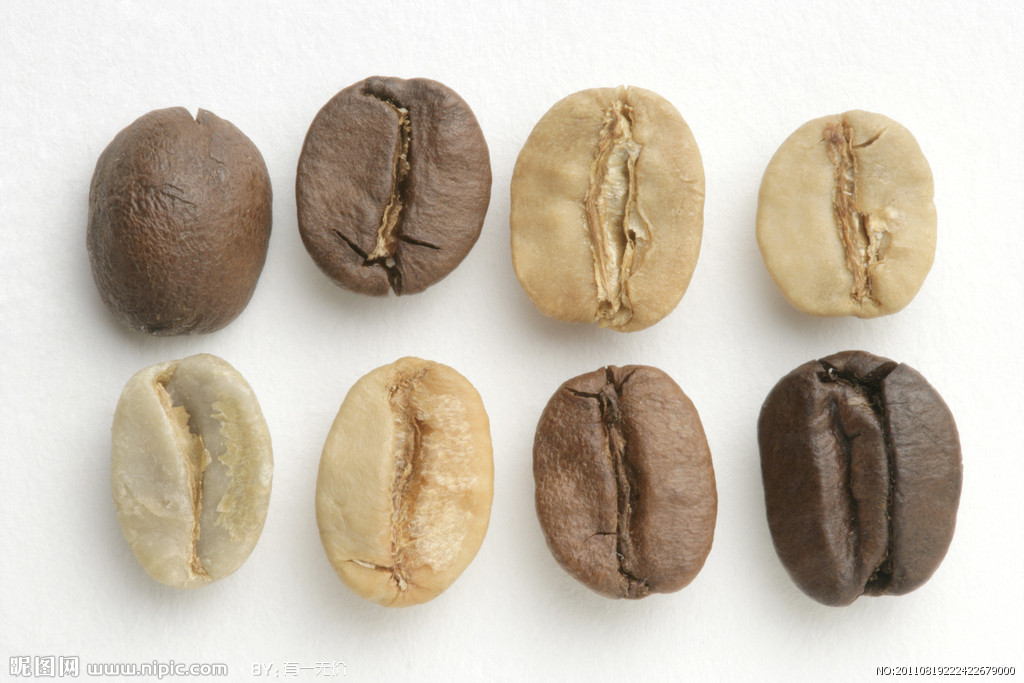Coffee roasting Coffee Coffee making Coffee made at Home Coffee Italian mixed with beans
1 is the state of raw coffee beans
2. Coffee beans are heating up at the furnace temperature.
3 as the temperature rises, the free water in the coffee beans begins to evaporate, and the beans begin to change from green to yellow. at this stage, the beans still have an obvious smell of grass.
(4) the coffee beans were further dehydrated and gradually changed from light yellow to longan-like colors. at this stage, the free water in the coffee beans was further removed, and the coffee beans gradually expanded.
5 the internal cells of coffee beans expand, accumulate heat and absorb a lot of heat, preparing for the first burst in the next stage.
The surface of the coffee bean becomes wrinkled, accumulating the last strength in an explosion, releasing the accumulated heat in a burst, crackling, and releasing an attractive fragrance.
When the first explosion is over, the coffee beans release heat and are once again designed to absorb heat and move forward to the second explosion.
8 entered the second explosion, the crackling sound was sporadic.
9 entered the second explosion dense, the bean surface is bright, under the burst action, some beans surface appears obvious "crater"
In fact, the whole process of coffee roasting is a process in which beans are heated, dehydrated, and roasted using the principle of heat conduction. in this process, the dehydration stage belongs to physical changes, and the chemical composition of coffee does not change. but this stage can be said to be the key to determining the quality of a pot of beans, because it is the force accumulated in the dehydration stage that drives the chemical changes in the next stage. Mena reflected that the beans entered an explosion and changed the chemical composition inside the coffee beans to form a unique aroma and flavor (which chemicals were produced and what specific substances were produced under specific conditions. Mankind has not yet studied thoroughly). The intense force in the previous stage is not enough to promote the effective chemical projection of coffee beans, and too much will make the reaction too fast to make the change develop completely.

Important Notice :
前街咖啡 FrontStreet Coffee has moved to new addredd:
FrontStreet Coffee Address: 315,Donghua East Road,GuangZhou
Tel:020 38364473
- Prev

Basic data of domestic common domestic Italian coffee machine Aibao E61 double boiler Huijia 210
There are many kinds of coffee machines in the international coffee industry, but not many are common in China, even less suitable for household use, so it is easy to sort out and sort out some related content for reference when you buy it. I am not in the industry, nor can I claim to be an expert. Some of these machines have been used and some have not been used, so in order to ensure credibility, these numbers
- Next

Rolls-Royce Starbucks in la Marzocco Coffee Machine comes with Linea Italian Coffee
Friends who often go to Starbucks must be familiar with this machine. When you stand at the waiting table and wait for the coffee maker at the Starbucks store (Starbucks staff, not barista, just coffee maker), you can remember that the coffee maker in the bar has a personalized appearance. This is the la Marzocco family, the luxury brand in the coffee machine.
Related
- Beginners will see the "Coffee pull flower" guide!
- What is the difference between ice blog purified milk and ordinary milk coffee?
- Why is the Philippines the largest producer of crops in Liberia?
- For coffee extraction, should the fine powder be retained?
- How does extracted espresso fill pressed powder? How much strength does it take to press the powder?
- How to make jasmine cold extract coffee? Is the jasmine + latte good?
- Will this little toy really make the coffee taste better? How does Lily Drip affect coffee extraction?
- Will the action of slapping the filter cup also affect coffee extraction?
- What's the difference between powder-to-water ratio and powder-to-liquid ratio?
- What is the Ethiopian local species? What does it have to do with Heirloom native species?

